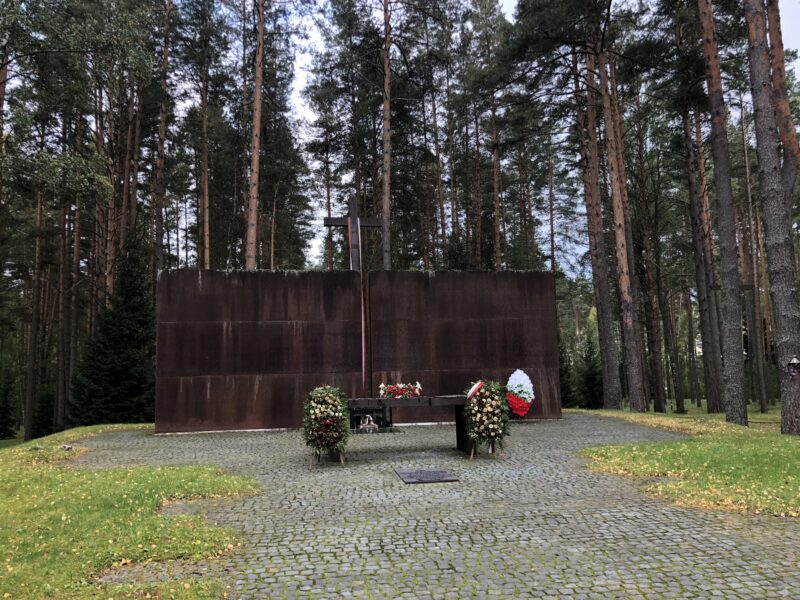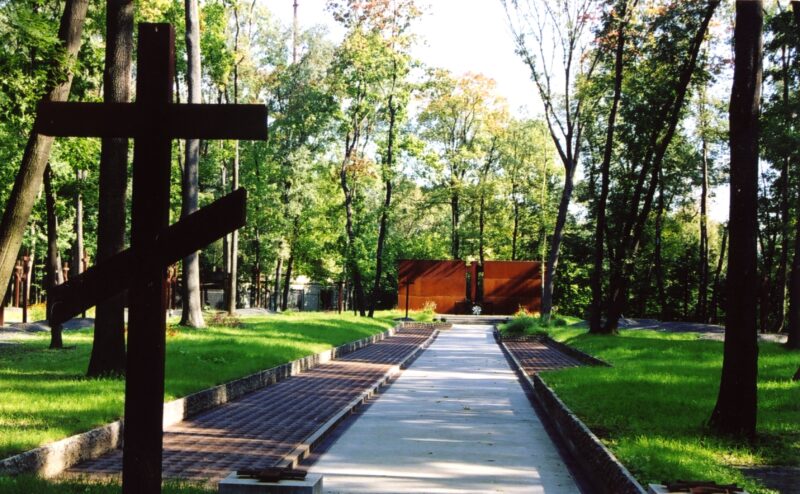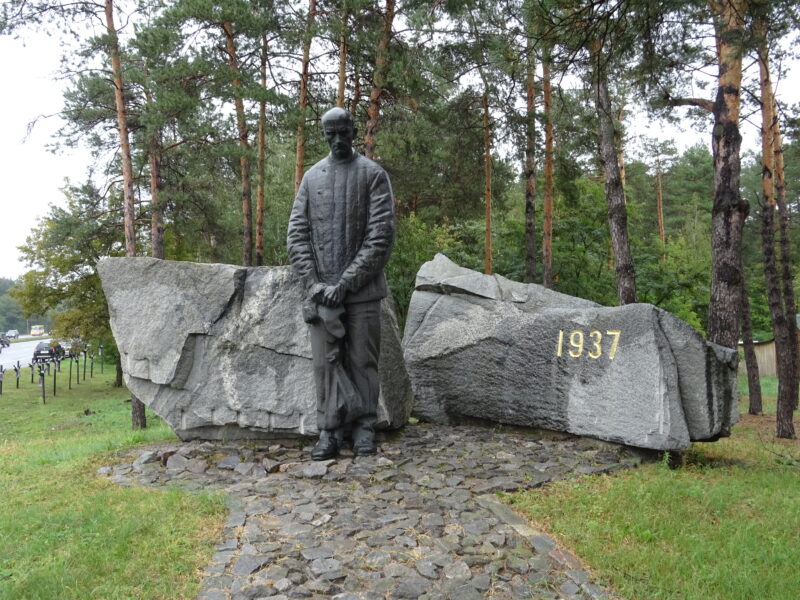Katyn
The Polish War Cemetery is part of the Katyn Memorial Complex, which also comprises Russian memorials to victims of Soviet repressions. The Cemetery is located in a forest complex between the Gnezdovo railway station and the village of Katyn, 20 kilometres west of the centre of Smolensk.
The entire memorial complex, including the Polish cemetery, is a branch of the Central State Museum of Modern Russian History in Moscow, administered by the Ministry of Culture of the Russian Federation.
The bodies of 4,415 prisoners of war from the Kozelsk camp, murdered in April and May of 1940 in Smolensk, lie in the Polish War Cemetery in the Katyn Forest.

The construction of the museum complex was initiated by a decree issued by the Government of the Russian Federation in 1996, entitled ‘On the creation of memorial sites at the resting places of Soviet and Polish citizens who were victims of totalitarian repressions in Katyn and Mednoe’.
The Polish War Cemetery in Katyn was solemnly opened and consecrated on 28 July 2000, as part of commemorative events marking the 60th anniversary of the Katyn Massacre. The conceptual work and construction of the Polish War Cemetery in Katyn was coordinated by the Council for the Protection of Struggle and Martyrdom Sites. The architectural design of the cemetery was authored by a team headed by sculptors Zdzisław Pidek and Andrzej Sołyga. This project became a point of reference for many commemorations of the victims of Soviet repressions.
The construction of the cemetery was financed from funds provided by the Polish government and those collected by the Katyn Families and the Polish Katyn Foundation, as well as contributions from other donors.

The Russian cemetery was officially opened in 2000, together with the Polish one, as a burial place of at least 8,000 victims of repressions who were residents of the Smolensk region, including at least several hundred Poles, mainly victims of the NKVD’s ‘Polish operation’ carried out in 1937–1938. The Russian part of the cemetery was neglected for many years – it was decorated only by a 10-metre high Orthodox cross placed behind the red gate, and wooden crosses put up by the victims’ families. Only the museum pavilion located at the entrance to the memorial complex served as a reminder of the Soviet and Polish victims of political repressions in the USSR.
On 20 April 2018, the reconstructed Russian cemetery was ceremonially opened. At its centre stands a sculptural composition entitled ‘Execution’ by Andrei Kovalchuk, his father Nikolai, as well as Vadim Frolov and Sofia Shlonkina [Софья Шлёнкина]. The monument depicts a figure of a man being executed, just before he falls, surrounded by concrete pylons. The background is made up of a memorial wall with the names of victims of Soviet repressions engraved in it.

A museum pavilion was also opened in the Russian part of the cemetery. Its exhibition entitled ‘Russia and Poland. 20th century. Cards from History’ presents a falsified, imperial vision of Polish-Russian relations.
Mednoe
The Mednoe Memorial Complex, with the Polish War Cemetery being part of it, is located 32 km from the town of Tver and 2 km from the village of Mednoe, near the Moscow-Petersburg motorway. It is a branch of the Central State Museum of Modern Russian History in Moscow, administered by the Ministry of Culture of the Russian Federation.

The Russian part of the Mednoe Memorial Complex is dedicated to the memory of Soviet citizens who were victims of political repressions between the 1930s and 1950s. The Polish War Cemetery in Mednoe is the resting place for at least 6,295 POWs from the Ostashkov camp, mainly officers of the State Police, the Police of the Silesian Province, the Border Guard and the Prison Guard, as well as soldiers and officers of the military police and the Border Guard Corps, who were murdered in the NKVD’s internal prison in Kalinin (currently: Tver) and buried in Mednoe.
The Mednoe Memorial Complex operates on the basis of the decree issued by the Government of the Russian Federation in 1996, entitled ‘On the creation of memorial sites at the resting places of Soviet and Polish citizens who were victims of totalitarian repressions in Katyn and Mednoe’.
The Polish War Cemetery in Mednoe was officially opened and consecrated on 2 September 2000. It was created through the endeavours undertaken by the Council for the Protection of Struggle and Martyrdom Sites and funded by the government of the Republic of Poland and donations collected by Katyn Families and groups commemorating the Katyn massacre, both in Poland and around the world.

As in the case of the cemeteries in Katyn and Kharkiv, the architectural design was authored by a team led by sculptors Zdzisław Pidek and Andrzej Sołyga. Mednoe displays all elements characteristic of the Katyn cemeteries: a gate with pylons, an altar complex with an ‘underground’ bell of remembrance, death pits marked with slabs, as well as epitaph plates with names of the Victims. The cemetery does not have vertical panels with symbols of different religions and denominations since only Roman Catholics were imprisoned in Ostashkov.
The architectural concept of the Russian part of the cemetery was designed by Nikita Shangin. The design includes an ‘Alley of Remembrance’ connecting two symbolic mass graves of victims of repressions, as well as a memorial sign located in the centre of a triangular square, in the form of an embankment with a red granite cross set in it, bearing the following inscription: ‘To Compatriots – Victims of War and Repressions’. It was authored by sculptor Yuri Karpenko and architect Aleksandr Sokolov.

In 2005, a permanent museum exhibition dedicated to the history of Soviet repressions in 1930–1950 was opened on the territory of the Mednoe State Memorial Complex. The exhibition consists of two parts. The first one, entitled ‘Decision taken: Shoot them!’, presents the fate of repressed citizens of the Kalinin region through archival documents and personal items. The second part of the exhibition, entitled ‘Difficult return’, is devoted to the rehabilitation of victims of political repressions in the Soviet Union.
Kharkiv
The Cemetery of the Victims of Totalitarianism in Kharkiv is located in a forest park at the northern outskirts of the city, near the district of Pyatikhatki. Nameless pits in the 6th quarter of the forest park became the burial place of the victims of Soviet repressions murdered in the headquarters of the NKVD Regional Directorate in Kharkiv, located in the very centre of the city.
For many years, the site was guarded and inaccessible, surrounded by a high wooden fence topped with barbed wire. After World War II, it was a location of a holiday home and dachas for KGB employees.

Exhumation works carried out in 1991 and 1994–1996 confirmed that the Kharkiv forest was the burial place for the bodies of at least 3,820 Polish officers and cadets of the regular service and reserve of the Polish Army from the camp in Starobelsk. The works also helped to establish the burial sites of Soviet citizens murdered by the NKVD during the Great Terror of 1937–1938, with Ukrainians, Russians, Poles, Belarusians, Jews and others among them.
On 17 June 2000, in the presence of the Prime Ministers of Poland and Ukraine, the first Katyn cemetery was officially opened: it was built in the place where the bodies of the victims of the Katyn Massacre were secretly buried. Like the cemeteries in Katyn and Mednoe, the Cemetery of the Victims of Totalitarianism in Kharkiv was designed by Zdzisław Pidek and Andrzej Sołyga. The design was adapted to match the character of the commemoration, i.e. as a common Polish-Ukrainian Cemetery of the Victims of Totalitarianism.

Reliefs depicting the Polish military eagle and the national emblem of Ukraine are placed at the main entrance to the cemetery. Visitors walk along the so-called Black Road, paved with basalt paving stones. Signs of the four religions professed by the murdered victims are displayed between the entrance and the cemetery proper.
The death pits, where the remains of the victims were originally buried, are marked with irregular mounds with cast-iron crosses on top: Roman Catholic ones on the Polish graves and Orthodox ones on the Ukrainian graves.
An element that has been preserved is an altar complex with a cast-iron wall with the names of the murdered Starobelsk POWs engraved on it, together with a bell of remembrance, and alleys with the Victims’ individual epitaph plates. The Ukrainian altar wall, decorated with an Orthodox cross, commemorates 2,746 Victims of Stalinist political repressions: Soviet citizens known by name.

The Cemetery of the Victims of Totalitarianism in Kharkiv was funded by the Republic of Poland, mainly from governmental funds transferred to the Council for the Protection of Struggle and Martyrdom Sites, as well as from donations collected by the Katyn Families and the Polish Katyn Foundation.
Following the Russian Federation’s invasion of Ukraine, Russian cluster shells fell on the Cemetery of the Victims of Totalitarianism on 23 March 2022. One of the shells hit the concrete fence, and two ended up inside the cemetery. The body of a cluster shell sank into the pedestal of one of the crosses, and its shrapnel destroyed the area around it, including the epitaph plates with the names of the Victims.
Bykivnia
The Polish War Cemetery in Kyiv-Bykivnia (Bykovnia) is located in the 19th and 20th quarters of the Dnipro Forestry, close to the exit road towards the village of Brovary, approx. 15 km northeast of the city centre. The Cemetery is part of the ‘Bykivnia Graves’ National Memorial-Historical Reserve.

This is where tens of thousands of prisoners executed by the NKVD in Kyiv prisons were buried in nameless mass graves in 1937–1941. Ukrainians were the largest group of those murdered, but the victims also came from many other nationalities living in the Soviet Union, including Poles – victims of the NKVD’s ‘Polish operation’.
The Ukrainian-Polish archaeological excavations and exhumation works conducted in 2001–2012 confirmed that Bykivnia was the burial site for the victims of the Katyn Massacre. The cemetery is the resting place of the majority of at least 3,435 Polish citizens from the so-called ‘Ukrainian List’ (‘Tsvetukhin List’). Held as prisoners, they were taken to be executed by the NKVD in April and May of 1940 from prisons located on the eastern territories of the Second Polish Republic occupied by the USSR.

For many years, the truth about this site was distorted by the Soviet authorities. In 1945, 1971 and 1987, three state-level commissions announced that Bykivnia was the burial place for victims of fascism. At that time, the graves were plundered by looters and the remains buried there were desecrated. The trees wrapped with ‘rushnyks’ (embroidered towels) by the relatives of the victims were the only sign of truth and a sign of remembrance. It was not until July 1989 that the Soviet authorities admitted that the site was a burial place for victims of Stalinist repressions.
In 1994, Ukrainian President Leonid Kuchma adopted a decision to create a memorial complex in Bykivnia. At that time, the first Ukrainian official commemorations of the victims of Soviet repressions were held in the Bykivnia forest. On 24 June 2001, Pope John Paul II visited Bykivnia as part of his official visit to Ukraine. However, the ‘Bykivnia Graves’ Memorial Site, together with the Fourth Polish War Cemetery, was not opened officially until 21 September 2012, in the presence of the Presidents of Poland and Ukraine.

The Polish War Cemetery in Bykivnia was designed by architect Robert Głowacki (Air Projekt) and artist Marek Moderau (Moderau Art). Both authors invoked the concept underlying the cemeteries in Katyn, Mednoe and Kharkiv while creatively interpreting and developing it further. Rust-coloured corroding metal was replaced by noble grey granite. The distinctive elements of the Katyn cemeteries were kept, while only the bell of remembrance was hung on a low bell tower decorated with symbols of religions and denominations. The cemetery was built owing to many years of endeavours undertaken by the Council for the Protection of Struggle and Martyrdom Sites and it was funded by the Republic of Poland.

The architectural concept of the Ukrainian part of the cemetery was authored by Larysa Skoryk. Its main elements include the ‘Wall of Remembrance’ with engraved names of the victims, the ‘Brotherly Grave’ covered with a large stone mound with ten crosses, and a monument to the victims of political repressions in Ukraine, consisting of two large marble slabs with holes with jagged edges, resembling gunshot wounds.
Based on:
K. Kunert, A. Siwek, Z. Walkowski, Polski Cmentarz Wojenny w Kijowie-Bykowni (czwarty cmentarz katyński), Rada Ochrony Pamięci Walk i Męczeństwa (Council for the Protection of Struggle and Martyrdom Sites), Warszawa 2012.
Polski cmentarz wojenny Kijów-Bykownia: księga cmentarna, vol. 1, edited by A. K. Kunert, Rada Ochrony Pamięci Walk i Męczeństwa (Council for the Protection of Struggle and Martyrdom Sites), Warszawa 2015.
‘Bykivnia Graves’ National Memorial-Historical Reserve, http://ua.bykivnya.org (accessed: 6 April 2022).
Charków. Księga Cmentarna Polskiego Cmentarza Wojennego, edited by J. Ciesielski et al., Rada Ochrony Pamięci Walk i Męczeństwa (Council for the Protection of Struggle and Martyrdom Sites), Warszawa 2003.
Gajowniczek, B. Gronek, B. Kayzer et al., (eds.), Miednoje. Księga Cmentarna Polskiego Cmentarza Wojennego, vol. 1, headed by: G. Jakubowski, Rada Ochrony Pamięci Walk i Męczeństwa (Council for the Protection of Struggle and Martyrdom Sites), Warszawa 2005.
Adamska, Katyń Miednoje 1940–2000, Biuletyn Rady Ochrony Pamięci Walk i Męczeństwa „Przeszłość i Pamięć”, No. 3 (16) 2000, p. 4.
Mednoe Memorial Complex, http://www.mk-mednoe.ru (accessed: 6 April 2022)
Katyn: In the Footsteps of the Crime, J. Rogoża, M. Wyrwa, Publisher: Centre for Polish-Russian Dialogue and Understanding, Warszawa 2019.
Katyn Memorial Complex, http://memorial-katyn.ru (accessed: 6 April 2022).